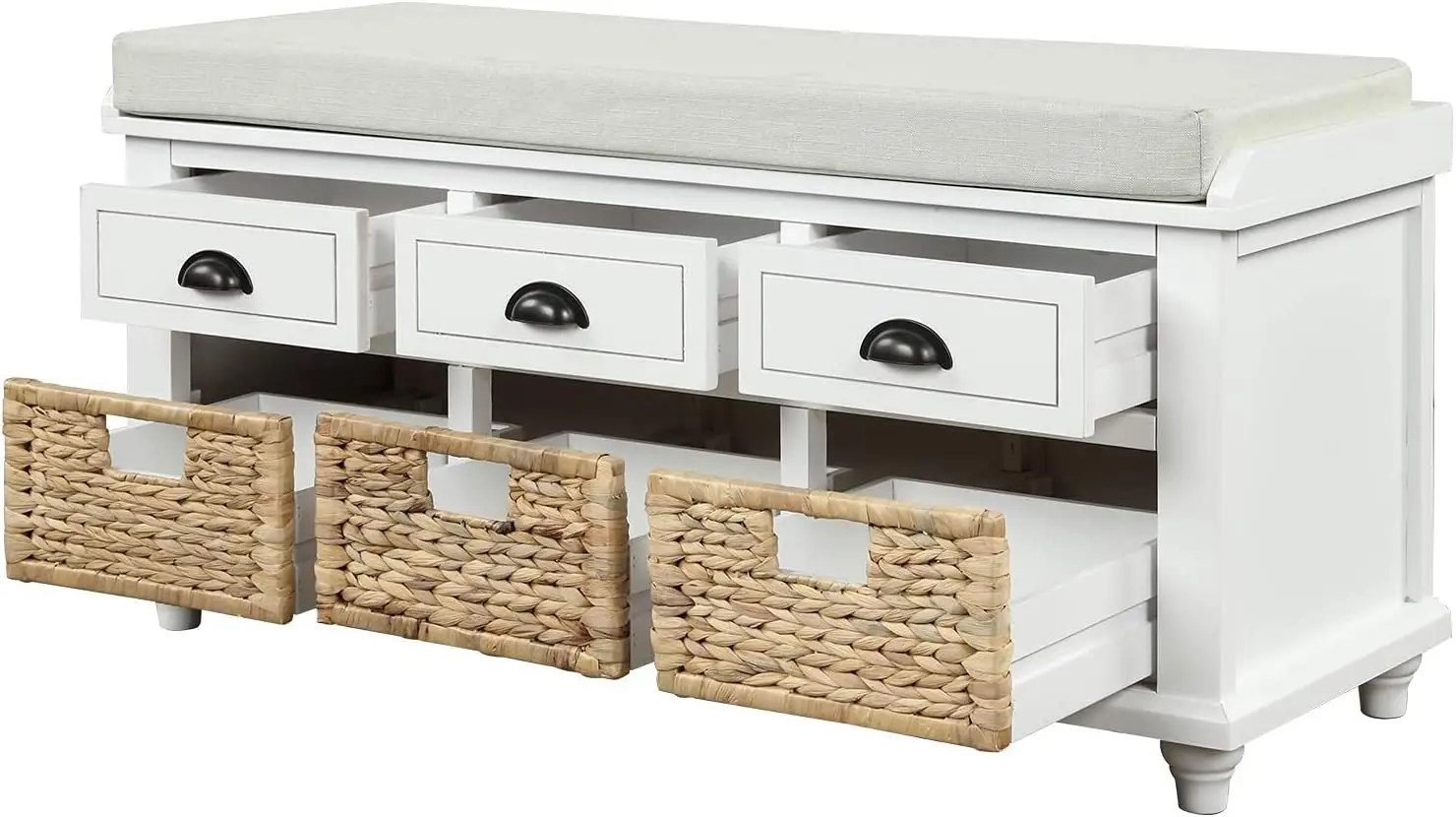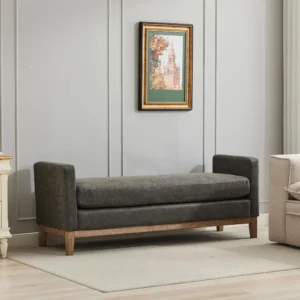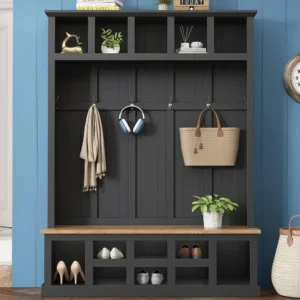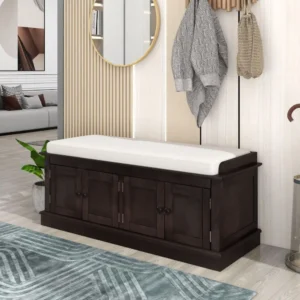Understanding the Value of Dual-Purpose Mudroom Seating
The humble mudroom serves as the first line of defense against the chaos that enters our homes daily. As families navigate busy schedules, these transitional spaces often become cluttered battlegrounds of shoes, coats, bags, and seasonal gear. Enter dual-purpose mudroom seating – thoughtfully designed furniture that combines comfortable seating with intelligent storage capabilities, specifically created to bring order to entryway spaces.
Many homeowners face common mudroom challenges that impact daily life:
- Limited square footage that quickly becomes overwhelmed
- Accumulation of seasonal items with nowhere to go
- Lack of designated places for everyday essentials
- Morning bottlenecks as family members prepare to leave
A well-designed mudroom bench serves as both a practical spot to remove shoes and a strategic storage solution. This integration of form and function represents the perfect marriage between aesthetics and practicality – pieces that look beautiful while working hard behind the scenes.
The benefits of investing in dual-purpose seating extend beyond simple organization:
- Space efficiency: Makes the most of limited square footage by combining two furniture functions
- Improved organization: Creates designated homes for frequently used items
- Streamlined routines: Facilitates smoother transitions between indoor and outdoor activities
- Enhanced home value: Adds both aesthetic appeal and practical functionality
Research shows that the average mudroom in American homes measures just 50-75 square feet, yet needs to accommodate storage for multiple family members. Studies have also demonstrated that organized entryways significantly reduce household stress levels and morning chaos. The strategic organization of small entryway spaces can transform how you experience your home daily.
Throughout this guide, we’ll explore the various styles, features, and considerations to help you find the perfect dual-purpose seating solution for your mudroom – no matter its size or your aesthetic preferences.
Essential Features of High-Quality Mudroom Seating
When investing in mudroom seating, certain quality features separate merely adequate pieces from those that will serve your family beautifully for years to come. Because this area of your home experiences such heavy traffic and exposure to the elements, durability must be a primary consideration.
Durability Requirements
A high-quality mudroom bench must withstand:
– Daily use from multiple family members
– Wet boots, umbrellas, and outdoor gear
– Seasonal temperature and humidity fluctuations
– The weight of adults sitting while putting on shoes
– Potential impacts from bags, sports equipment, and more
Ergonomic Considerations
The perfect entryway bench height falls between 16-18 inches from the floor, which provides comfortable seating for most adults while allowing children to easily climb on and off. Depth is equally important – 15-20 inches allows people to sit comfortably without protruding too far into walkways.
For enhanced comfort, many homeowners opt for mudroom bench cushions that can be easily removed for cleaning or seasonal changes. Look for cushions with removable, washable covers in durable, stain-resistant fabrics.
Storage Accessibility
The best storage solutions are those that actually get used. Consider these accessibility factors:
– Can children easily open and close storage compartments?
– Are compartments the right size for your intended items?
– Will the opening mechanism function well after years of use?
– Can the storage areas be easily cleaned when necessary?
– Is the design intuitive enough that family members will actually use it?
Weather Resistance
Mudrooms bear the brunt of whatever weather conditions exist outside. Quality seating should feature:
– Moisture-resistant finishes that prevent warping or water damage
– Non-rusting hardware that withstands humidity
– Materials that won’t easily stain from wet or muddy items
– Surfaces that can be wiped clean without damage
– Construction methods that allow for proper air circulation
These essential features ensure your investment will maintain both its functionality and appearance despite the challenging conditions typical in mudroom environments. When evaluating options, prioritize sturdy construction, quality materials, and thoughtful design that addresses these specific requirements.
Storage Benches: The Versatile Foundation of Mudroom Design
Storage benches represent the most popular and versatile foundation for mudroom organization, offering the perfect blend of seating and storage in a relatively compact footprint. These multipurpose pieces come in countless variations to suit different space requirements and storage needs.
Types of Storage Benches
The world of entryway bench storage options includes several distinct categories:
Built-in Custom Benches
– Maximizes every inch of available space
– Can be designed to fit unusual dimensions or angles
– Often features integrated cabinets above or below
– Creates a cohesive, architectural look
– Typically requires professional installation
Freestanding Lift-Top Benches
– Offers flexibility to move or rearrange as needed
– Single large storage compartment accessed from the top
– Ideal for storing bulkier items or seasonal gear
– Available in countless styles to match any decor
– Generally more affordable than custom built-ins
Flip-Top Benches with Divided Compartments
– Internal dividers create organized sections
– Perfect for families to assign personal storage spaces
– Prevents smaller items from getting lost
– Provides better organization than single-compartment designs
– Often includes safety hinges to prevent lid slamming
Window Seat Storage Benches
– Utilizes space beneath windows that might otherwise be wasted
– Creates cozy seating with natural light
– Can include drawers or lift-top storage
– Often shallower in depth to accommodate window placement
– Maximizes natural light in the mudroom
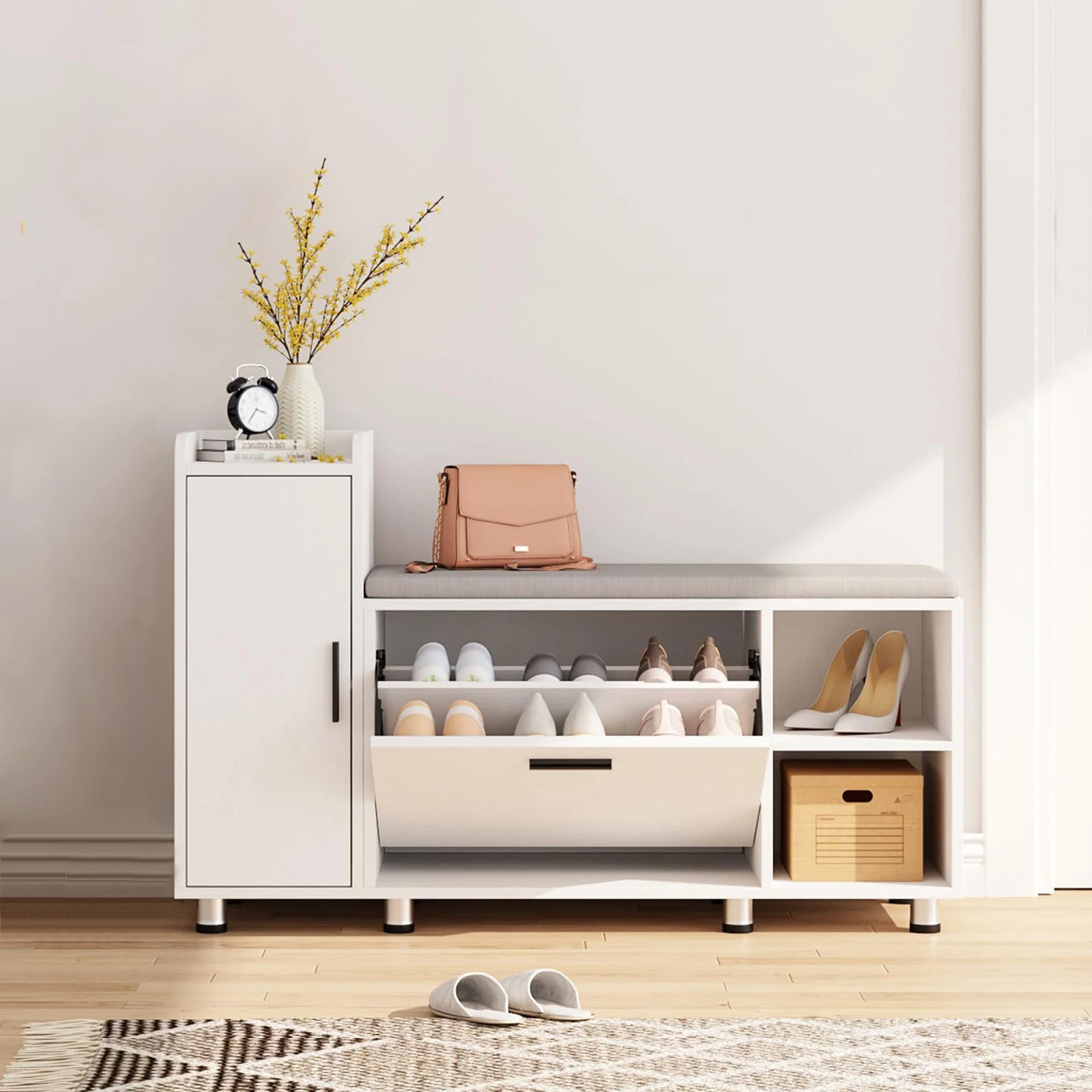
The average storage bench offers 6-10 cubic feet of storage space – enough to store several pairs of shoes, winter accessories, pet supplies, or sports equipment. Materials range from solid hardwoods like oak and maple to engineered woods with protective finishes, each offering different aesthetics and durability profiles.
For homes with particularly tight entryways, specialized space-saving entryway seating solutions incorporate clever features like narrower profiles, corner designs, or multifunctional elements that maximize every available inch.
When selecting a storage bench, consider not just the external dimensions but the actual usable storage volume inside. Some designs sacrifice storage capacity for aesthetic features, while others maximize interior space with thoughtful engineering and minimal framing.
Hall Trees with Integrated Seating: Complete Entryway Solutions
For those seeking comprehensive mudroom organization, hall trees with integrated seating offer the most complete solution in a single furniture piece. These multifunctional units combine seating, storage, and hanging space for coats and accessories – essentially creating a mini-mudroom even in homes without a dedicated entryway space.
A standard hall tree typically stands 60-72 inches tall and combines:
– A bench base with storage (often lift-top or cubbies)
– Vertical panels with hooks for coats and bags
– Upper shelving for additional storage or display
– Sometimes mirror panels for last-minute appearance checks
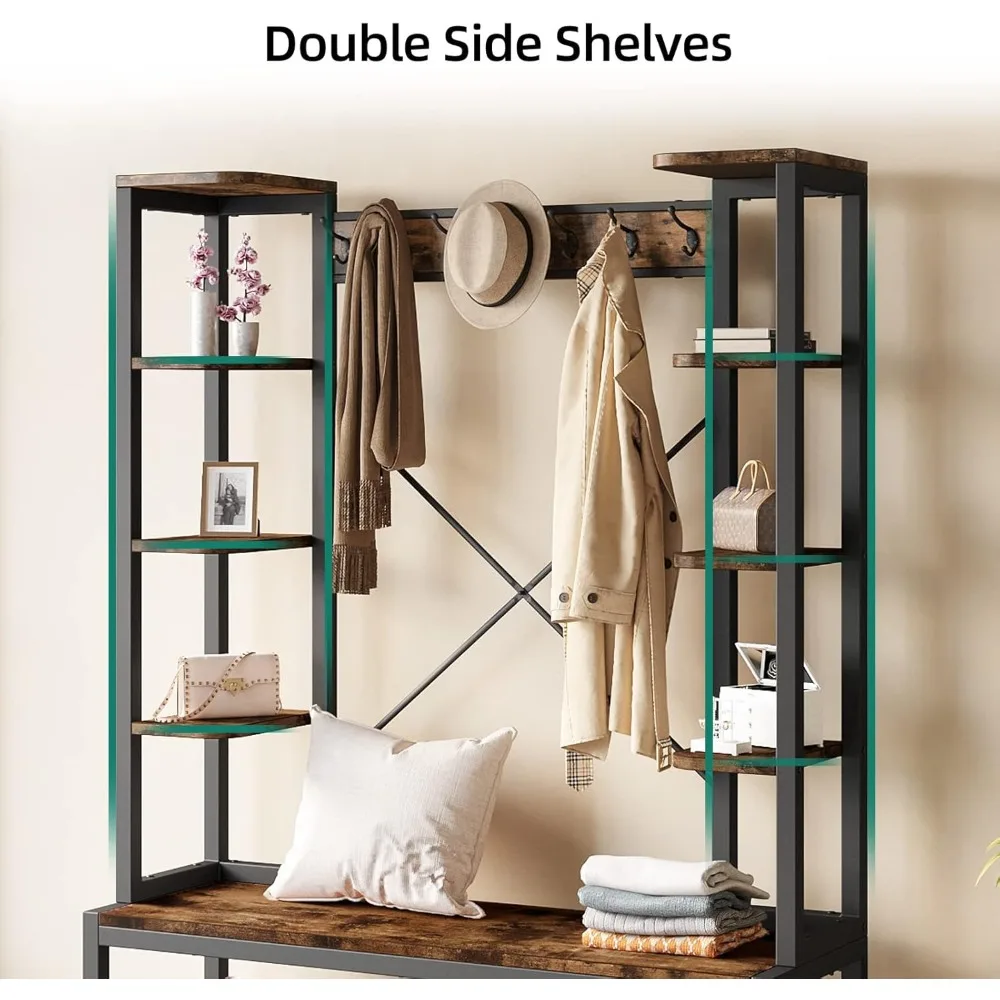
Popular Hall Tree Configurations
Classic Full-Height Hall Trees
These traditional designs feature substantial construction with a bench base and tall back panel reaching 6 feet or higher. Our hall trees and coat rack benches collection includes options with multiple hooks, often arranged on both sides of a central mirror, providing extensive hanging space for multiple family members.
Corner Hall Trees
Designed specifically to maximize awkward corner spaces, these clever units fit snugly into 90-degree corners. Despite their space-efficient footprint, quality corner units still provide ample seating and storage while making use of often-wasted corner areas.
Modern Minimalist Designs
Contemporary hall trees feature sleeker profiles with simplified lines, often incorporating metal frames with wood accents. These designs work particularly well in urban apartments or homes with modern aesthetics where bulkier traditional pieces might overwhelm the space.
Locker-Style Units
Inspired by school lockers but with much more style, these compartmentalized designs create individual sections for each family member. This approach minimizes morning confusion as everyone has their designated space for belongings.
Entryway hall trees provide significant organizational advantages by consolidating multiple furniture functions into one footprint. When shopping for these versatile pieces, pay particular attention to:
- Weight capacity for both the seating area and hooks
- Stability and tipping prevention features
- Overall dimensions in relation to your available space
- Hook height accessibility for all family members
- Storage volume within benches or cubbies
With thoughtful selection, a quality hall tree can transform your entryway from a chaotic collection point into an organized transition space that welcomes you home while keeping essentials perfectly arranged.
Cubby Systems with Bench Seating: Customized Organization
Cubby systems represent one of the most customizable and visually organized approaches to mudroom seating. These systems combine open or closed compartments with comfortable bench seating, creating designated spaces for each family member or category of items.
Open vs. Closed Storage
Open cubby systems offer several advantages:
– Increased visibility of contents prevents items from being forgotten
– Better air circulation for damp items like shoes or gloves
– Easier access for children and adults alike
– Visual reminder to maintain organization
– Opportunity to display decorative baskets or bins
Closed storage with doors or drawers provides:
– A cleaner, more minimalist appearance
– Protection from dust for less frequently used items
– Concealment of necessary but less attractive items
– More sophisticated aesthetic for formal entryways
– Potential for added security with locking options
Many mudroom bench cubbies incorporate both approaches, with open compartments for frequently accessed items and closed storage for seasonal or occasional use items.
Configuration Options
Cubby systems can be arranged in multiple ways:
Vertical Configurations
– Taller cubbies for boots and sports equipment
– Medium-height spaces for shoes and purses
– Smaller compartments for gloves, hats, and accessories
– Often includes hooks above each section
Horizontal Arrangements
– Side-by-side compartments creating a lower profile
– Well-suited for spaces with limited ceiling height
– Can extend along walls to accommodate multiple users
– Often incorporates drawers beneath the bench seat
Individual vs. Shared Storage
For families, assigning dedicated cubby sections to each member prevents morning confusion and teaches organizational habits. Color-coding or labeling individual spaces can further enhance this system, while small benches for entryways might feature just a few compartments for more compact spaces.
The most successful cubby systems incorporate:
– Appropriately sized compartments for intended items
– Sturdy dividers that won’t warp or bend
– Easy-to-clean surfaces inside each compartment
– Optional bins or baskets for smaller items
– Sufficient seating space above or in front of storage areas
A thoughtfully designed cubby system transforms chaotic mudroom spaces into orderly transition areas where every item has its designated home – making both departures and arrivals smoother for the entire household.
Space-Saving Seating Alternatives for Compact Mudrooms
Not every home enjoys the luxury of a spacious mudroom. For those with limited entryway square footage, innovative space-saving seating solutions can provide the functionality of larger mudroom furniture without overwhelming smaller spaces.
Clever Space-Maximizing Designs
Fold-Down Wall-Mounted Seating
– Attaches securely to wall studs
– Folds up when not in use to free up floor space
– Some models include small storage compartments
– Typically supports 250-300 pounds when properly installed
– Ideal for extremely narrow hallways or tiny apartments
Narrow Profile Flip-Top Benches
– Slimmer depth (12-14 inches versus standard 16-18 inches)
– Still provides essential storage despite smaller footprint
– Works well in hallway-style mudrooms
– Often features vertical storage emphasis to compensate for reduced width
– Available in both modern and traditional styles
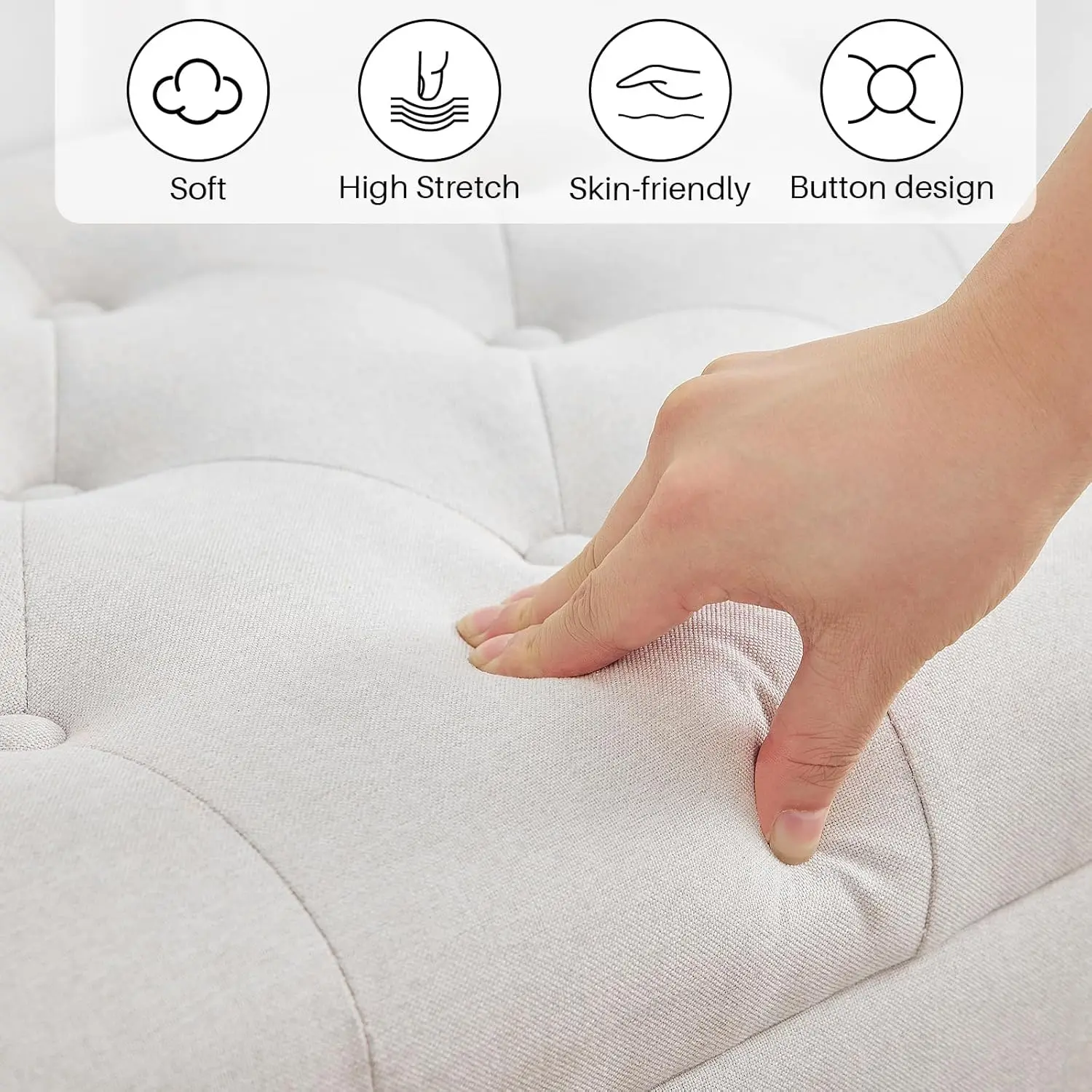
Nesting Ottomans with Storage
– Sets of two or three differently sized storage ottomans
– Tuck inside each other when not in use
– Can be distributed throughout space when needed
– Multifunctional as seating, storage, and footrests
– Easily moved for cleaning or reconfiguration
Corner-Optimized Solutions
– L-shaped designs that make use of often-wasted corner space
– Triangular corner benches that fit snugly into 90-degree corners
– Some include diagonal storage compartments specifically engineered for corners
– Makes use of spaces that standard rectangular furniture cannot utilize
Maximizing small spaces with smart entryway bench solutions requires thinking beyond conventional furniture dimensions. Look for pieces specifically designed for compact areas rather than trying to squeeze standard-sized furniture into tight spaces.
Vertical Storage Emphasis
When floor space is limited, look upward. Many compact seating solutions incorporate vertical storage elements:
– Wall-mounted cabinets above bench seating
– Taller, narrower hall trees with smaller bench footprints
– Hooks and hanging systems that utilize wall space
– Stackable components that grow upward instead of outward
The corner hall tree represents one of the most efficient space-saving solutions, tucking neatly into corners while still providing seating, hanging space for coats, and often storage within the bench portion.
With thoughtful selection and placement, even the smallest entryways can incorporate functional seating with storage capabilities – bringing order to limited spaces without sacrificing style or essential mudroom functions.
Material Selection Guide for Durability and Style
The materials used in mudroom seating significantly impact both durability and aesthetic appeal. This high-traffic transition area between outdoors and indoors requires particularly resilient materials that can withstand moisture, dirt, and heavy use while maintaining their appearance.
Material Comparison Guide
| Material | Durability | Moisture Resistance | Maintenance | Cost | Best For |
|---|---|---|---|---|---|
| Solid Oak/Maple | Excellent (25+ years) | Good with proper finish | Moderate | High | Long-term investment pieces |
| Pine | Good (15+ years) | Fair – prone to dents | Moderate | Moderate | Rustic/farmhouse styles |
| MDF/Engineered Wood | Fair (8-12 years) | Poor unless well-sealed | Low | Low-Moderate | Budget-friendly options |
| Metal Frame/Wood Combo | Excellent (20+ years) | Excellent | Low | Moderate | Industrial or modern styles |
| Laminate | Good (10+ years) | Excellent | Very Low | Low | Easy-clean family mudrooms |
| Upholstered Seating | Varies by fabric | Poor unless treated | High | Moderate | Comfort-focused designs |
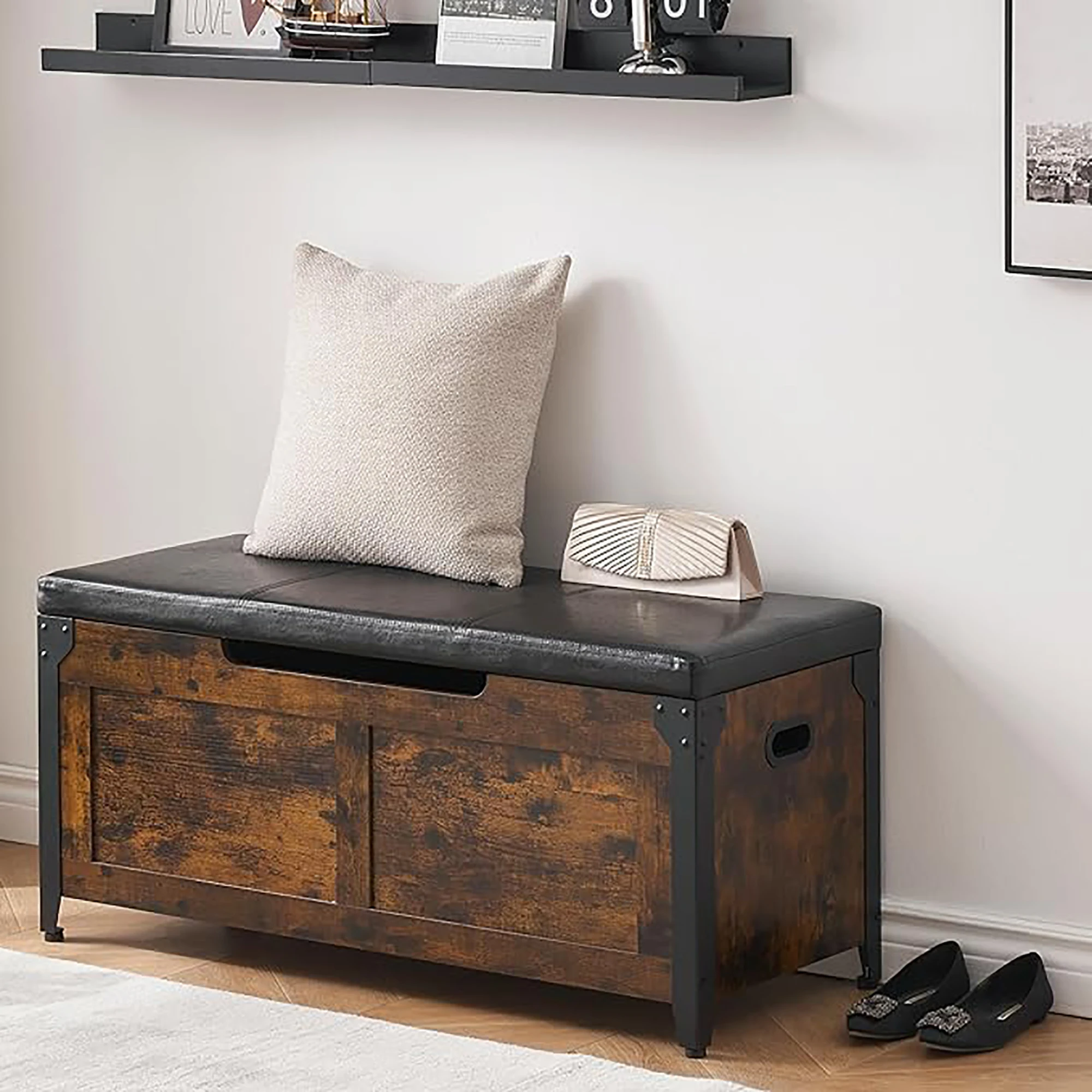
Climate Considerations
Your local climate should influence material selection:
High Humidity Regions
– Prefer kiln-dried hardwoods with moisture-resistant finishes
– Look for marine-grade plywood rather than standard varieties
– Consider powder-coated metal components to prevent rust
– Avoid untreated woods that may warp or expand
Cold Winter Climates
– Choose materials that won’t feel uncomfortably cold (wood over metal)
– Select fabrics designed for high performance and quick drying
– Ensure finishes won’t crack under temperature fluctuations
– Consider thermal properties if mudroom isn’t well heated
Our collection of wood mudroom benches features options specifically designed to withstand these environmental challenges with proper construction techniques and protective finishes.
Cleaning and Maintenance Requirements
Different materials demand varying levels of maintenance:
Solid Woods
– Regular dusting and occasional polishing
– Immediate wiping of spills and moisture
– Periodic reapplication of protective finishes every 1-3 years
– Touch-up of minor scratches or dents as needed
Engineered Woods/Laminates
– Simple wipe-down cleaning with mild cleaners
– Protection from excessive moisture that can penetrate seams
– Avoid abrasive cleaners that may damage protective finishes
– Less maintenance overall but shorter lifespan
Metal Components
– Regular checking and tightening of fasteners
– Wiping with appropriate metal cleaners to maintain finish
– Lubrication of any moving parts
– Inspection for early signs of rust or corrosion
Upholstery
– Vacuuming to remove dirt and debris
– Prompt cleaning of spills and stains
– Consideration of removable, washable covers
– Potential need for professional cleaning annually
By selecting materials appropriate to your climate, household needs, and maintenance preferences, you’ll ensure your mudroom seating remains both beautiful and functional for many years.
Designing Your Mudroom Seating to Match Your Home’s Style
Your mudroom creates a first impression of your home’s interior while setting the tone for your daily transitions. Selecting seating that complements your overall home style creates cohesion and elevates this utilitarian space beyond mere functionality.
Style-Specific Characteristics
Farmhouse/Rustic
The warmth and charm of farmhouse style makes it particularly popular for mudroom spaces. Look for:
– Distressed or reclaimed wood with visible grain patterns
– Simple, practical designs with minimal ornamentation
– Matte or low-sheen finishes that show natural wood character
– Black iron or bronze hardware with vintage-inspired designs
– Natural fabric cushions in neutral tones or classic patterns
Our farmhouse mudroom bench collection features authentic details like beadboard panels, X-frame accents, and weathered finishes that capture this welcoming aesthetic.
Modern/Contemporary
For homes with cleaner, more minimalist design sensibilities:
– Streamlined silhouettes with minimal decorative details
– Mixed material combinations like metal and wood
– Neutral color palettes with occasional bold accent colors
– Hidden storage with touch-latch doors or seamless drawers
– High-gloss finishes or matte lacquers for smooth surfaces
Traditional/Classic
Timeless design elements create elegance even in utilitarian spaces:
– Rich wood tones in cherry, walnut, or mahogany finishes
– Detailed moldings and thoughtful architectural elements
– Brass or bronze hardware with antique patinas
– Symmetrical designs with balanced proportions
– Upholstered elements in timeless patterns like stripes or subtle plaids
Transitional Styles
For homes that blend traditional comfort with contemporary clean lines:
– Simplified versions of classic forms
– Neutral color palettes with textural interest
– Combination of straight lines with subtle curves
– Minimal but thoughtful detailing
– Mix of materials like wood with metal accents or stone tops
Rustic farmhouse bench designs can be easily adapted to complement many home styles beyond strictly farmhouse aesthetics. The key is identifying core elements from your home’s existing design language and finding seating that incorporates these same characteristics.
When selecting hardware, consider how it relates to other visible elements in adjacent spaces. Coordinating finishes (brushed nickel, oil-rubbed bronze, etc.) creates visual harmony between your mudroom and neighboring rooms, enhancing the sense of intentional design throughout your home.
Measuring and Planning Your Ideal Mudroom Seating
Proper planning ensures your mudroom seating not only fits physically but functions effectively for your specific household needs. This methodical approach prevents costly mistakes and disappointments.
Step-by-Step Measurement Process
Measure Total Available Space
– Width and depth of potential seating area
– Height limitations if installing under windows or existing hooks
– Door swing arcs that cannot be obstructed
– Electrical outlets or vents that must remain accessibleDetermine Traffic Flow Requirements
– Allow minimum 36-inch clearance for walkways
– Consider wider clearances for households with mobility aids
– Map the natural path people take when entering/exiting
– Account for door swings (both entry doors and closets)Assess Storage Needs By Household Size
– Small households (1-2 people): 3-4 linear feet of seating/storage
– Medium households (3-4 people): 5-7 linear feet of seating/storage
– Large households (5+ people): 8+ linear feet, potentially with multiple units
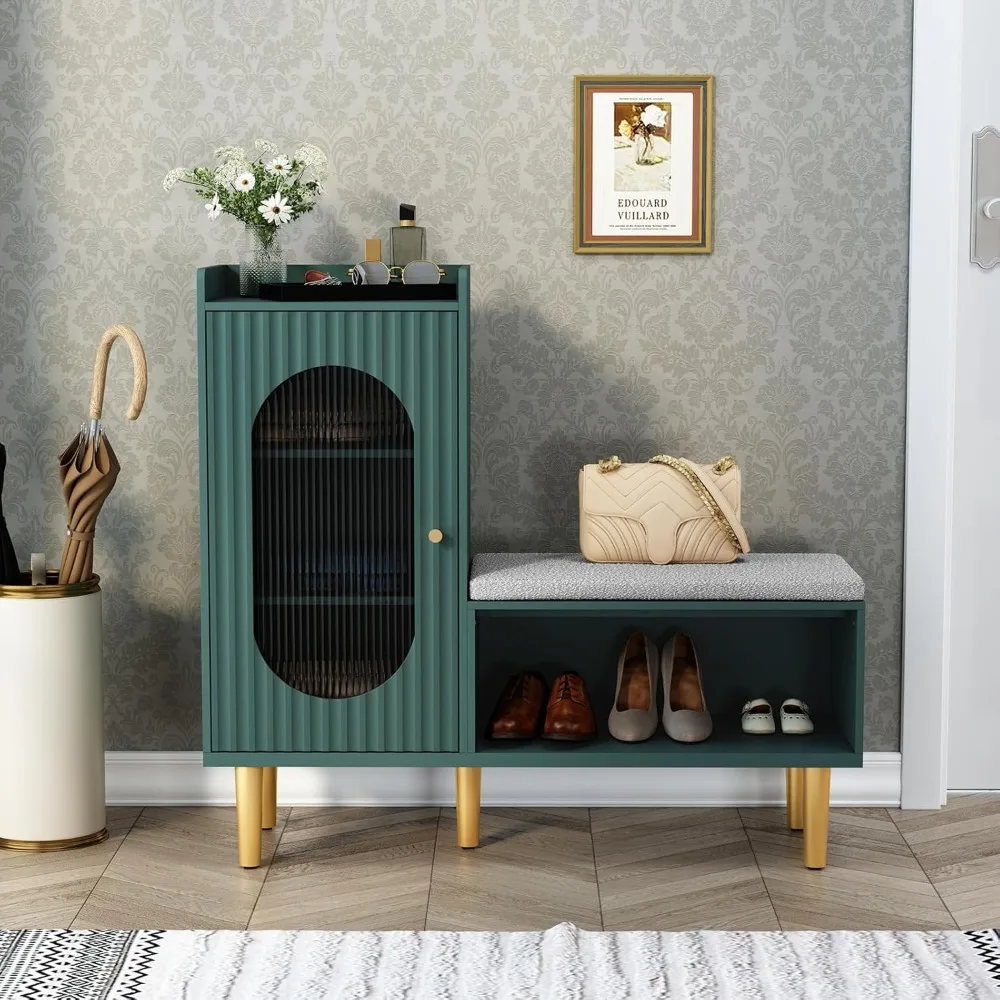
Consider User Height Variations
– Standard bench height: 16-18 inches for average adults
– Lower options (14-15 inches) better for households with small children
– Hook placement: multiple heights for different family members
– Upper storage accessibility for primary usersPlan for Growth and Seasonal Changes
– Winter gear requires significantly more storage than summer items
– Children’s storage needs change as they grow
– Guest accommodation during high-traffic periods
– Flexibility to reconfigure as needs evolve
Space-saving entryway ideas can help optimize even challenging floor plans. Consider creating a simple scale drawing of your space with all measurements clearly marked. This allows you to “test fit” different seating options without physically moving furniture.
Adjacent Space Considerations
Your mudroom doesn’t exist in isolation. Consider how it interacts with:
– Kitchen traffic patterns if nearby
– Living area visibility (how much of the mudroom is visible from main living spaces)
– Laundry room access if combined or adjacent
– Garage entry requirements if connected
– Outdoor views and natural light sources
Proper lighting is essential for mudroom functionality. Ensure seating areas are well-illuminated for activities like tying shoes, finding items in storage compartments, and checking appearance before leaving. Consider both overhead and task lighting for optimal visibility.
By taking this comprehensive planning approach, you’ll create a mudroom seating arrangement that truly serves your family’s specific needs rather than simply filling space with furniture.
Smart Organizational Systems for Dual-Purpose Seating
The true power of dual-purpose mudroom seating lies in thoughtfully designed organizational systems that integrate seamlessly with seating functions. These practical additions transform basic storage into highly efficient systems tailored to your specific needs.
Integrated Organization Solutions
Baskets and Bin Systems
– Removable for cleaning and reorganizing
– Easily labeled for family member assignments
– Available in various materials to match décor (seagrass, fabric, wire)
– Prevent smaller items from getting lost in larger compartments
– Can be replaced individually if damaged or soiled
Drawer Dividers and Inserts
– Create designated spaces for smaller essentials
– Prevent tangled messes of gloves, scarves, and accessories
– Available in adjustable formats to change with seasonal needs
– Keep electronics, keys, and valuables separate and protected
– Allow for logical grouping of related items
When choosing a compact bench with organizational features, consider how your family actually uses the space. Observe current pain points in your entry routine and select organizational systems specifically designed to address these challenges.
Technology Integration
Modern mudroom seating can incorporate surprising tech features:
– Hidden charging stations for devices
– Smart home control panels concealed within cabinetry
– Motion-activated lighting inside storage compartments
– RFID or Bluetooth trackers for frequently lost items
– USB ports integrated into bench frames
Specialized Storage Accessories
Benches with hooks and storage create vertical organization opportunities that complement seating functions:
- Adjustable hook systems for different height users
- Specialized holders for frequently used items (umbrellas, dog leashes)
- Mail and document sorting slots
- Key management systems
- Seasonal shoe trays or boot storage
Maintenance and Organization Routines
Even the best organizational systems require periodic maintenance:
– Schedule quarterly reorganization to address changing seasonal needs
– Implement a “one in, one out” policy for high-traffic areas
– Establish family routines for returning items to designated locations
– Regularly assess if current systems still meet evolving household needs
– Clean and inspect organizational components for damage or wear
The most effective organizational systems feel intuitive and natural to use. When family members can easily maintain organization without complicated instructions or reminders, your mudroom seating will continue functioning beautifully throughout changing seasons and household needs.
Entryway Bench with Cushion, Mudroom Bench with Cushion, Shoe Bench for Entryway
$1,186.63 Select options This product has multiple variants. The options may be chosen on the product pageCoat Rack Shoe Bench, Corner Entryway Bench, Corner Hall Tree, Shoe Bench for Entryway
$313.58 Select options This product has multiple variants. The options may be chosen on the product pageBench with Hooks and Storage, Entryway Hall Tree, Mudroom Bench with Cubbies, Mudroom Bench with Shoe Storage
$818.38 Select options This product has multiple variants. The options may be chosen on the product pageModern Entryway Bench, Wood Entryway Bench, Wood Mudroom Bench
$497.69 Select options This product has multiple variants. The options may be chosen on the product pageEntryway Coat Rack Bench, Entryway Hall Tree, Farmhouse Mudroom Bench, Mudroom Bench with Shoe Storage
$805.09 Select options This product has multiple variants. The options may be chosen on the product pageEntryway Bench with Cushion, Mudroom Bench with Cabinets, Shoe Bench for Entryway, Shoe Bench with Cushion
$991.71 Select options This product has multiple variants. The options may be chosen on the product page
Installation Options: Freestanding vs. Built-In Seating
The installation approach for your mudroom seating significantly impacts both immediate functionality and long-term flexibility. Understanding the advantages of different installation methods helps you make the best choice for your specific situation.
Freestanding Seating Advantages
Freestanding mudroom seating offers considerable benefits:
- Flexibility for rearrangement as needs change or when redecorating
- No installation requirements beyond simple assembly
- Immediate use without construction delays
- Ability to take with you when moving to a new home
- Lower initial investment compared to custom built-ins
- Easier replacement if damaged or when styles change
- Simple seasonal reconfiguration for changing storage needs
These advantages make freestanding options particularly appealing for renters, those in transition, or homeowners who appreciate design flexibility. The functional mudroom seating solutions available as ready-to-use pieces offer impressive quality and features without permanent commitment.
Built-In Seating Benefits
Custom built-in seating provides different advantages:
- Maximizes every available inch of space with custom dimensions
- Creates a high-end, architectural appearance
- Can be designed around irregular features like angled walls or pipes
- Potentially increases home resale value as a permanent improvement
- Offers complete customization of storage configuration
- Provides stability that eliminates tipping concerns
- Creates a cohesive look that integrates with adjacent cabinetry
Built-ins generally cost 30-50% more than comparable freestanding pieces but offer tailored solutions for challenging spaces and architectural integration that ready-made furniture cannot match.
Semi-Permanent Alternatives
For those seeking middle ground between fully built-in and completely freestanding options:
- Anchored freestanding pieces secured to wall studs
- Modular systems that connect together but can be reconfigured
- Ready-made cabinets installed in built-in configurations
- Hybrid approaches combining some built-in elements with freestanding components
These alternatives offer enhanced stability and a more integrated appearance while maintaining some flexibility for future changes.
The best installation approach depends on your specific circumstances including homeownership status, length of expected residence, budget constraints, and how certain you are about your long-term needs and preferences.
Making the Final Selection: Questions to Guide Your Decision
With so many attractive options available, finalizing your mudroom seating decision requires focused consideration of your specific household needs and priorities. These key questions will help you narrow your choices to find the perfect solution.
Essential Decision-Making Questions
How many people will use this space daily?
The number of regular users directly impacts the seating length and storage volume required. For larger households, consider multiple seating units or longer bench systems that accommodate several people simultaneously.
What specific items need storage in this area?
Create an inventory of items that need homes in your mudroom:
– Shoes and boots (quantity and types)
– Coats and jackets (seasonal variations)
– Accessories (hats, gloves, scarves)
– Sports equipment
– Pet supplies
– School or work bags
– Seasonal items like umbrellas or sunscreen
What is your realistic budget for this project?
Quality mudroom seating ranges widely in price:
– Simple storage benches: $150-$500
– Hall trees with seating: $300-$1,200
– Custom built-in solutions: $1,000-$5,000+
Our affordable entryway bench solutions provide quality options at various price points without sacrificing essential features.
How permanent is your living situation?
Your expected time in your current home should influence your investment level and installation approach:
– Temporary (1-2 years): Focus on freestanding, transferable pieces
– Medium-term (3-5 years): Consider semi-permanent installations
– Long-term (5+ years): Might justify custom built-ins and higher-end investments
What are your primary functional priorities?
Rank these aspects in order of importance for your specific needs:
– Maximum storage volume
– Comfortable seating
– Ease of cleaning
– Visual appearance
– Specialized organization
– Durability for children/pets
What aesthetic elements matter most?
Consider which visual aspects will bring you satisfaction:
– Material preferences (wood, metal, upholstered)
– Color palette coordination with adjacent spaces
– Style consistency with your home’s overall design
– Statement piece vs. subtle background element
– Display opportunities for decorative items
By thoughtfully answering these questions, you’ll clarify which features truly matter for your specific situation, making it easier to identify the perfect dual-purpose seating solution among the many available options.
Maintaining Your Mudroom Seating: Care Tips for Longevity
Proper maintenance ensures your mudroom seating remains beautiful and functional for years to come. This high-traffic area requires regular attention to prevent damage from moisture, dirt, and daily wear.
Material-Specific Care Guidelines
Wood Care
– Dust weekly with a soft cloth
– Clean spills immediately to prevent water damage or staining
– Apply furniture polish or conditioner quarterly (follow product recommendations)
– Touch up minor scratches with matching repair pens or crayons
– Re-oil or rewax natural wood surfaces annually as needed
– Keep out of direct sunlight to prevent fading or drying
Metal Component Maintenance
– Wipe clean with appropriate metal cleaner
– Check for and address any rust spots immediately
– Tighten any loose screws or fasteners quarterly
– Apply touch-up paint to chips to prevent corrosion
– Lubricate hinges and moving parts as needed
Upholstery Preservation
– Vacuum regularly to remove dirt and debris
– Treat stains promptly according to fabric recommendations
– Consider removable, washable covers for easy cleaning
– Apply fabric protector products designed for heavy-use areas
– Rotate or flip cushions regularly for even wear
– Keep away from direct sunlight to prevent fading
Seasonal Maintenance Schedule
Spring
– Deep clean all surfaces after winter mud and salt exposure
– Reorganize storage for warm weather gear
– Check for damage from winter use and address promptly
– Air out cushions and wash removable covers
Fall
– Prepare storage for bulkier winter items
– Check hinges and hardware before heavy winter use
– Apply protective treatments to wood or metal surfaces
– Clean and store summer-specific items
When to Refinish or Replace
Watch for these warning signs that indicate need for attention:
– Wood splitting or severe scratches beyond surface level
– Hardware that cannot be tightened or repaired
– Structural wobbling that creates safety concerns
– Water damage that has penetrated finishes
– Upholstery tears that cannot be mended
– Mold or mildew growth that persists after cleaning
With proper care, quality mudroom seating should last 10-15 years before requiring significant restoration or replacement. Investing time in regular maintenance protects your investment while ensuring your mudroom continues functioning beautifully for your family’s daily transitions.
Beyond Seating: Complementary Elements for a Complete Mudroom
While dual-purpose seating forms the foundation of a well-designed mudroom, complementary elements enhance both functionality and aesthetic appeal. These thoughtful additions create a cohesive space that truly serves as an effective transition between outdoors and indoors.
Wall Treatments
The walls surrounding your seating deserve consideration:
– Beadboard or shiplap adds texture and traditional charm
– Washable paint in semi-gloss or satin finishes withstands cleaning
– Decorative hooks or peg rails provide additional hanging storage
– Wipeable wallpaper with subtle patterns adds visual interest
– Wall-mounted organizers for mail, keys, and small items
Flooring Considerations
Mudroom flooring must balance durability with style:
– Porcelain or ceramic tile resists moisture and cleans easily
– Luxury vinyl plank offers wood-look with superior water resistance
– Natural stone provides durability with timeless appeal
– Indoor/outdoor rugs add warmth while standing up to traffic
– Proper transitions to adjacent flooring for seamless flow
Lighting Elements
Effective lighting transforms mudroom functionality:
– Overhead fixtures that fully illuminate the space
– Task lighting above seating areas for visibility
– Motion-activated options for hands-free operation
– Under-bench lighting to find items in lower storage
– Natural light maximization through windows or doors
Transitional Accessories
Practical elements that ease the indoor/outdoor transition:
– Boot trays or mats to contain moisture and dirt
– Umbrella stands or hooks for wet weather gear
– Mirror placement for last-minute appearance checks
– Small weather station for preparation before departing
– Decorative yet functional baskets for seasonal items
Space-saving entry benches for small homes can incorporate these complementary elements in scale-appropriate ways. Even in compact spaces, thoughtfully selected accessories enhance functionality without creating clutter.
When selecting these additional elements, maintain cohesion with your seating choices through consistent:
– Color palette coordination
– Material relationships (complementary woods or metals)
– Style language (modern, traditional, farmhouse, etc.)
– Quality level and durability standards
These complementary elements transform a simple seating area into a complete mudroom experience that smoothly manages the daily transitions between outdoor activities and your home’s interior spaces.
Are Dual-Purpose Seating Solutions Worth the Investment?
When considering the value proposition of dual-purpose mudroom seating, many homeowners question whether these specialized pieces justify their often higher price tags compared to simple benches or standard storage cabinets. The answer lies in analyzing both tangible and intangible benefits.
Cost-Benefit Analysis
From a purely financial perspective, dual-purpose seating typically offers strong value:
– Average cost of quality dual-purpose piece: $300-$800
– Comparable cost of separate bench and storage cabinet: $400-$1,000
– Space savings value (particularly in homes with limited square footage): $100-$300 per square foot in many markets
Beyond simple cost comparison, dual-purpose pieces eliminate the need for multiple furniture items, potentially saving hundreds of dollars while creating a more cohesive look.
Impact on Home Value
Real estate professionals consistently identify well-designed mudrooms as desirable features for potential buyers:
– Organized entryways create positive first impressions during showings
– Built-in storage solutions are frequently mentioned in listing descriptions
– Functional transition spaces rank high on buyer wish lists, particularly for family homes
– Professional appraisers may consider quality built-ins as home improvements rather than furnishings
While not as significant as kitchen or bathroom upgrades, thoughtfully designed mudroom spaces with quality seating and storage can contribute to overall home marketability and perceived value.
Long-Term Satisfaction
Perhaps most importantly, homeowner satisfaction with dual-purpose mudroom seating tends to remain high years after purchase:
– Daily functionality that simplifies routines
– Reduced entryway clutter and associated stress
– Improved home organization that ripples into other spaces
– Aesthetic improvement to often overlooked transitional areas
For most households, the combination of space efficiency, enhanced organization, and daily practical benefits makes dual-purpose mudroom seating a worthwhile investment that continues delivering value throughout its lifespan.
The best approach is selecting pieces that truly meet your specific needs rather than the most expensive or trend-forward options. A thoughtfully chosen bench with storage that perfectly addresses your family’s organizational challenges will provide far greater satisfaction than a showpiece that looks impressive but fails to solve your daily mudroom dilemmas.

